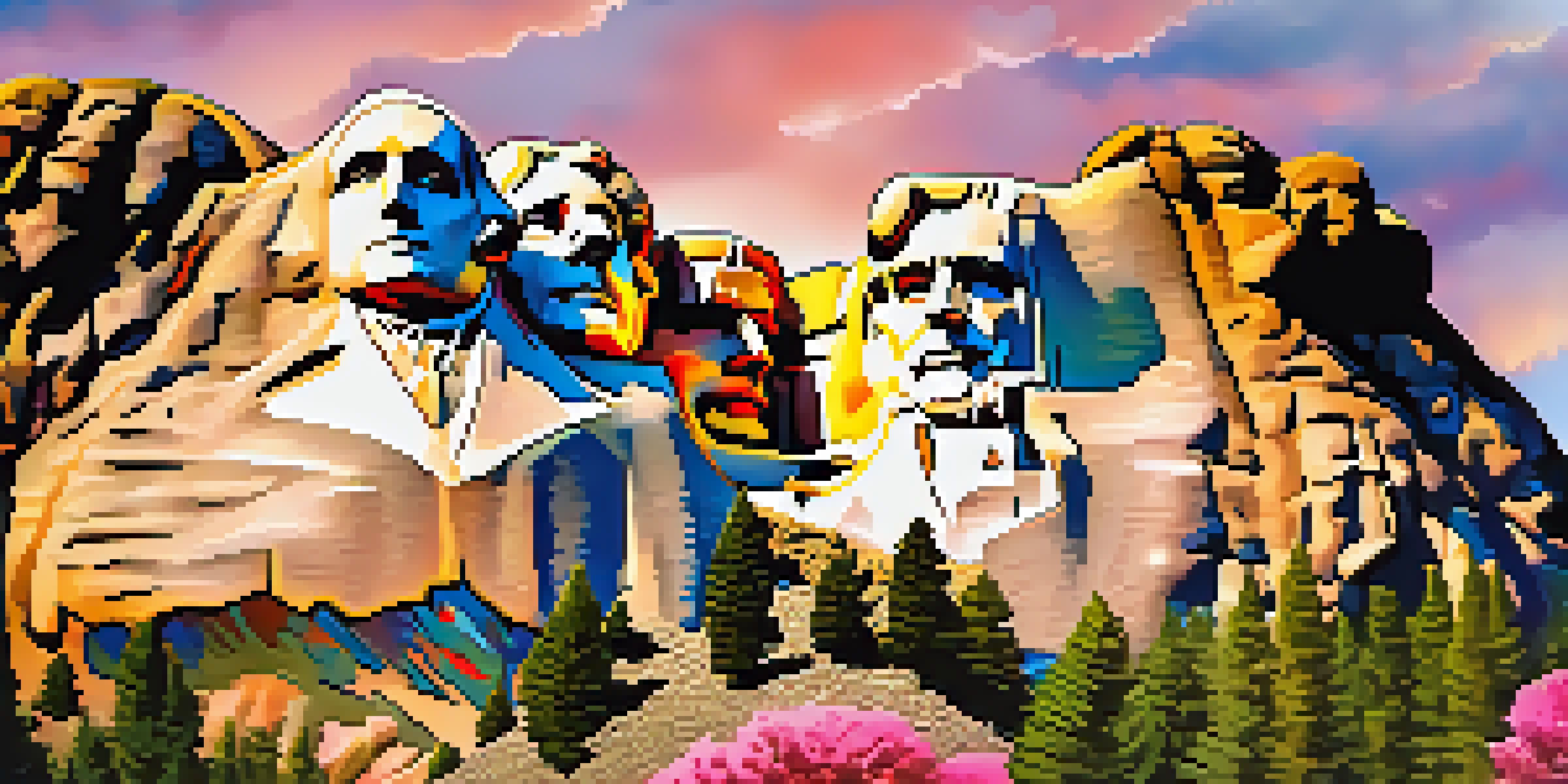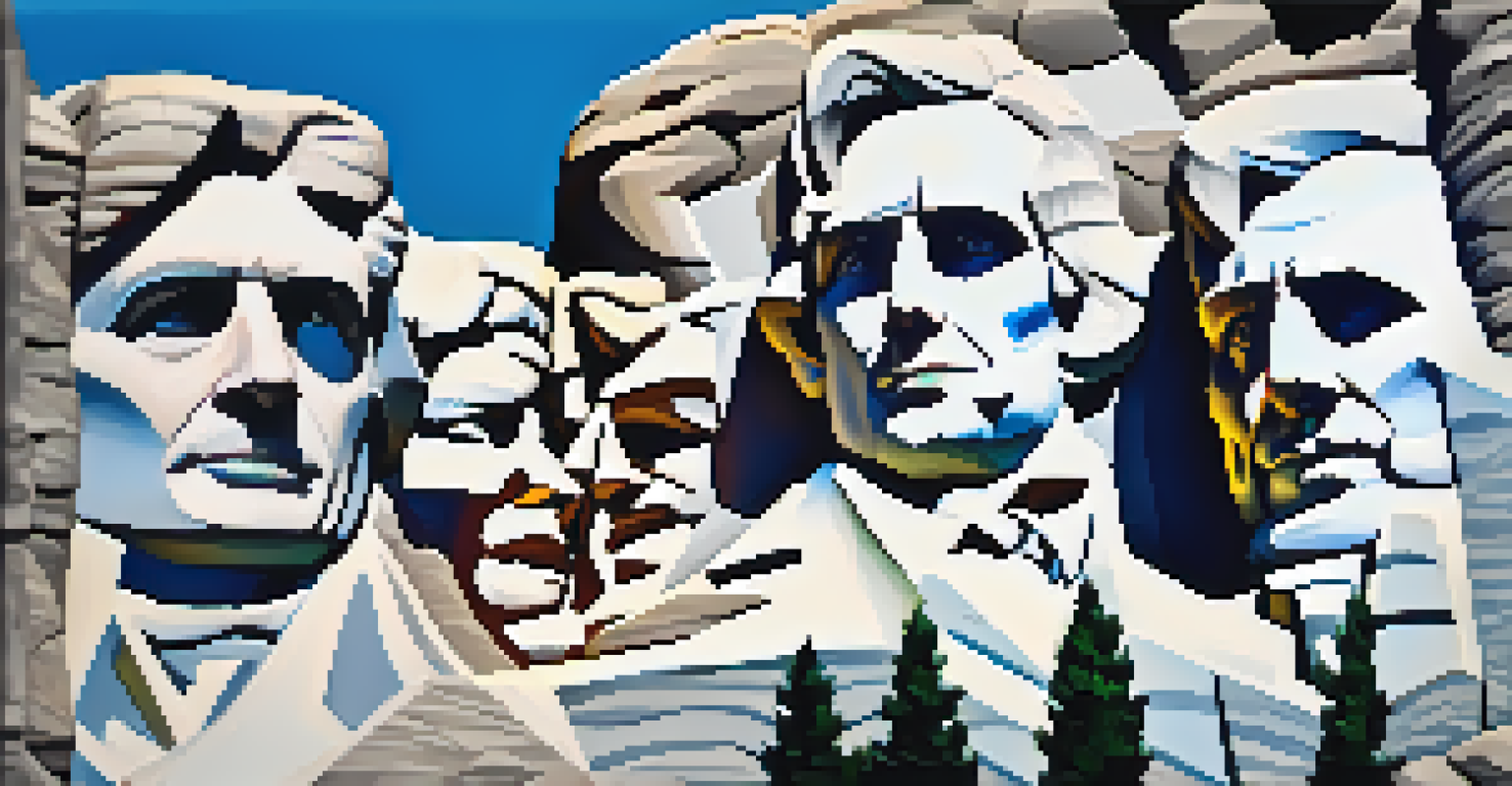Mount Rushmore: Carving a National Identity in Stone

The Vision Behind Mount Rushmore's Creation
Mount Rushmore stands as a monumental tribute to four of America's most influential presidents: George Washington, Thomas Jefferson, Theodore Roosevelt, and Abraham Lincoln. The vision began in the 1920s, spearheaded by sculptor Gutzon Borglum, who aimed to create a lasting symbol of American democracy. Borglum saw this project as not just art, but a way to inspire national pride and unity during a time of great social change.
The best way to predict the future is to create it.
The selection of these four presidents was no coincidence. Each was chosen for their pivotal role in shaping the nation—Washington for founding it, Jefferson for expanding it, Lincoln for preserving it, and Roosevelt for modernizing it. Thus, the mountain became a canvas for not only artistry but also a reflection of American ideals and values.
However, the journey to bring this colossal vision to life was fraught with challenges, including funding issues, technical difficulties, and the harsh conditions of the Black Hills. Yet, through determination and ingenuity, Borglum and his team carved out a testament to their commitment to American identity that would stand the test of time.
The Artistic Process of Carving Mount Rushmore
The artistic process of carving Mount Rushmore was nothing short of monumental. Using dynamite and smaller tools, workers blasted away tons of granite to shape the faces of the four presidents. This method, while explosive, allowed for significant material removal and was crucial in achieving the scale and detail needed for such an iconic sculpture.

Borglum's meticulous planning was evident throughout the project. He created models and sketches to ensure that the final product would not only be grand in size but also in artistic value. Each face was carefully scaled, and techniques were adapted as the team worked to capture the essence of these historical figures.
Mount Rushmore's Symbolic Significance
Mount Rushmore embodies ideals of freedom and democracy, inviting reflection on American history and values.
Despite the challenges, the artistic integrity of the project was never compromised. The combination of skilled labor, innovative techniques, and Borglum's vision culminated in a breathtaking piece of art that continues to captivate millions of visitors each year.
The Symbolism of Mount Rushmore
Mount Rushmore is rich in symbolism, representing the ideals of freedom, democracy, and the American spirit. Each president's face serves as a reminder of the struggles and triumphs that have shaped the nation. For many, it embodies the belief that America is a land of opportunity and perseverance, encouraging future generations to uphold these values.
History is written by the victors.
The mountain itself, set against the stunning backdrop of the Black Hills, adds to the monument's significance. These hills are considered sacred by the Lakota Sioux, and the contrast between the granite faces and the natural landscape highlights the ongoing conversation about cultural heritage and respect for indigenous peoples.
As visitors stand before the monument, they are invited to reflect on their own connection to American history and the ongoing journey toward equality and justice. In this way, Mount Rushmore transcends its physical presence, becoming a symbol of hope and a call to action for all who gaze upon it.
Mount Rushmore and American Nationalism
Mount Rushmore has become a powerful emblem of American nationalism, often celebrated for its grandeur and historical significance. During times of national crisis or celebration, it serves as a rallying point, reminding citizens of their shared identity and values. It's a place where Americans come together to honor their history and acknowledge the complexities of their nation's journey.
However, this nationalism is not without its critiques. Some argue that the monument oversimplifies the diverse narratives that make up American history. The focus on these four presidents can overshadow the contributions and experiences of many other individuals and groups who have played vital roles in shaping the nation.
Tourism's Economic Impact
The influx of tourists to Mount Rushmore supports local economies while also raising concerns about environmental sustainability.
Ultimately, Mount Rushmore sparks dialogue about what it means to be American. It challenges us to consider how we interpret our history and what aspects we choose to celebrate, ensuring that the conversation around national identity remains dynamic and inclusive.
The Impact of Tourism on Mount Rushmore
Tourism plays a significant role in the story of Mount Rushmore, drawing millions of visitors each year. This influx of tourists provides economic benefits to the surrounding region, supporting local businesses and creating jobs. The site has become a pilgrimage for many, as people from all walks of life come to witness this monumental piece of art up close.
However, the growing popularity of Mount Rushmore also raises concerns about environmental sustainability and the preservation of the site. With increased foot traffic, there’s a risk of damaging the delicate ecosystem of the Black Hills, necessitating careful management and conservation efforts to protect both the monument and its surroundings.
Moreover, as tourism evolves, there’s an opportunity to enhance visitor experiences by offering educational programs and cultural insights. This approach not only enriches the understanding of the monument's significance but also fosters a greater appreciation for the diverse narratives that are part of America's history.
Controversies Surrounding Mount Rushmore
While Mount Rushmore is often viewed as a symbol of American pride, it is not without its controversies. The monument is located on land that holds deep spiritual significance for the Lakota Sioux people, who were forcibly removed from their homeland. This historical context raises important questions about ownership, representation, and the impact of colonization.
Many argue that the monument represents a narrative that overlooks the experiences and voices of indigenous peoples. The celebration of these four presidents can be seen as a reflection of a broader historical narrative that has often marginalized the contributions of Native Americans and other groups.
Controversies Over Historical Narratives
The monument's location on sacred land for the Lakota Sioux highlights the need for dialogue about ownership and representation in American history.
Addressing these controversies requires open dialogue and a willingness to engage with the complex layers of history. By acknowledging the challenges and injustices faced by indigenous communities, society can move toward a more inclusive understanding of what Mount Rushmore represents in the broader tapestry of American identity.
The Future of Mount Rushmore
Looking ahead, the future of Mount Rushmore presents both opportunities and challenges. As societal values evolve, there may be calls for a reevaluation of how the monument is interpreted and presented to the public. This could involve incorporating more diverse perspectives and narratives that reflect the complexities of American history.
Moreover, advancements in technology could enhance visitor experiences, providing interactive elements that educate and engage audiences. Virtual reality, augmented reality, and multimedia displays could offer deeper insights into the lives of the presidents and the significance of the site, making history more accessible to all.

Ultimately, the future of Mount Rushmore lies in its ability to adapt and resonate with new generations. By fostering an inclusive dialogue about its meaning and significance, Mount Rushmore can continue to be a relevant and poignant symbol of national identity for years to come.